Editorial

Happy Fourth and welcome to the second age of space flight. It would be a big surprise to me if anyone who reads these pages regularly were unaware that on June 21 last, Mike Melville piloted a civilian rocket powered vehicle to an apogee of 328,491 feet (62 miles, 100km) and became the first civilian private pilot to earn astronaut wings. I feel this achievement—funded by Microsoft co-founder, Paul G Allen and engineered by aviation legend, Bert Rutan—has special relevance to these pages and to all free-flight modelers because the craft essentially descends under DT! That the pilot is 62 years old is also a source of grins for me. Well done to everybody at Scaled Composites and the other organizations that made this dream come true.
Progress on the Feeney project this month is again nill, except for the promised and delayed part of the construction series that describes how I completely misunderstood the Trimble method for making piston rings, but seem to have made workable rings anyway. This appears, cunningly disguised, as the Tech Un-Tip for the month and we'll get back to real tips next month. The Feeney itself is still all finished apart from the gaskets and final assembly, but the good news is the Death March project here is finished and some semblance of normality will return as soon as all the engineers, including yours truly, regain a degree of what passes for sanity amongst software engineers.
While recovering from our latest Death March, I've been reading an account of another death march called "Showstopper!". This is the story of the troubled birth of the Microsoft Windows NT operating system written by G Pascal Zachary (ISBN 0-7515-1629-5). Without meaning to cast aspersions on the engineers involved, hopefully they as an organization have learnt a thing or two about process since then as there are now only 19 months remaining until the time when Microsoft will produce the cure for Spam.
Seriously Schnuerle
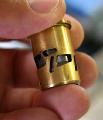
How's that for some serious Schnuerle porting in a cylinder liner? The photo was snapped by Ken Croft during yet another Walk in the Black Forest to the tether car track (Ken says aeromodeling could loose him to this pursuit if only there was a closer track). The engine the cylinder belongs to is a 3.5cc Nova Rossi. It produces 2.75 BHP at 34,000 RPM. There are nine (9) ports in that liner and we wonder if their size and placement are a result of theory or design evolution, or both? Whichever, 'tis a thing of beauty...
Constant Pressure Engines
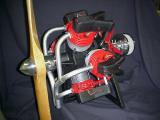
A photo of a neat six cylinder, dual bank radial in the issue of the EAA Sport Aviation that I received last month led me to the website of Constant Pressure Engines, Inc. These guys earned my grin of the month award for stating up front that the "Constant Pressure" in their name does not refer to a new IC operating principle, but to life in general for the staff!  The neat little radial turns out 65HP at 3000RPM and is intended as a more reliable, quieter, 4-stroke alternative for the 2-strokes powering a lot of ultralights today. It uses VW cylinders, pistons and valves (stainless racing type), but the rest is made by CPI. Unfortunately the site does not give any pictures of the engine with the rocker covers off, but from the text explanation of how the rockers and fore-aft valves are actuated, I think I can almost comprehend it—with stress on the "almost". The site also has some photos of a twin cylinder, horizontally opposed engine that segues neatly into the next item:
The neat little radial turns out 65HP at 3000RPM and is intended as a more reliable, quieter, 4-stroke alternative for the 2-strokes powering a lot of ultralights today. It uses VW cylinders, pistons and valves (stainless racing type), but the rest is made by CPI. Unfortunately the site does not give any pictures of the engine with the rocker covers off, but from the text explanation of how the rockers and fore-aft valves are actuated, I think I can almost comprehend it—with stress on the "almost". The site also has some photos of a twin cylinder, horizontally opposed engine that segues neatly into the next item:
The All Crow Diet
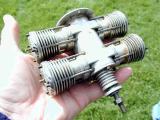
The month before the one just passed, a reader alerted me to Yet Another Booboo perpetrated by this site. Quite some time back, Ken Croft sent me some pics of a very nicely made Scotch-Yoke flat-four that left us mystified regarding how it was intended to be fed. Our reader asserts it is based on a design once patented by inventor, Russell Bourke. Like our mystery engine, the Bourke engine uses a Scotch-yoke and horizontally opposed pistons. Transfer is effected like the design patented by German inventor Alexander Thusius and described here in February this year. The Scotch Yoke design means conrod motion is linear, so by sealing around the conrod and using the volume under the piston as a pump, the engine becomes a series of intercoupled, but isolated two-strokes. With respect to the Whatzit engine, this is a plausible theory as to the eventual intent of the designer, but the engine was never completed and from the photos and Ken's visual inspection, there is absolutely no induction provision whatsoever. A disassembly of a cylinder, as suggested by my correspondent, may well have provided some clues, but alas, the opportunity to do that has passed.
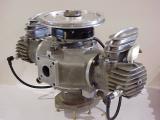 The connection with the Constant Pressure folk comes from the photos of an actual Bourke engine, serial number 001, circa 1957 that appears on their site. For more information about the Burke engines, visit Bourke Engine Com. From this site, you can order the Bourke Engine Documentary book and blueprints, or download electronic copies. To close off this topic (or not), the email pointed out that there is an improvement to the Scotch yoke that uses a double, floating slipper bearing to significantly reduce side-forces inherent with the more commonly encountered shoe design. All stuff well worth further investigation...
The connection with the Constant Pressure folk comes from the photos of an actual Bourke engine, serial number 001, circa 1957 that appears on their site. For more information about the Burke engines, visit Bourke Engine Com. From this site, you can order the Bourke Engine Documentary book and blueprints, or download electronic copies. To close off this topic (or not), the email pointed out that there is an improvement to the Scotch yoke that uses a double, floating slipper bearing to significantly reduce side-forces inherent with the more commonly encountered shoe design. All stuff well worth further investigation...
New Books and Magazines This Month
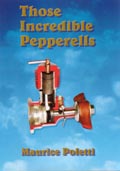
This month's first offering is one that has been advertised in ECJ for a while now, but one that despite several recommendations, I'd put off ordering. Finally, my nose was rubbed in a copy (thanks Russ, I think) and I ordered and received my own copy. It is, to say the least, very enlightening. The book is Those Incredible Pepperells by Maurice Poletti, ISBN 0-473-09990-X (a 10 digit, modulo 11 checksum ISBN as opposed to the 13 digit, modulo 10 variety—guess who had to write a validator for these not long ago?) You can email Maurie, or send A$40 in a plain wrapper to him at 69 Willis Road, Papakura 1703, New Zealand for your signed, air-mailed copy: 164 pages, 8" x 11-1/2", on high quality paper, profusely illustrated.
While I was vaguely aware that our trans-Tasman neighbour (New Zealand) had a pioneer home-grown engine called the "Pepperell", I never knew a lot about it. This book certainly fills that little knowledge gap. The father and son team of Vern and Ira Pepperell manufactured ignition (advertised as "Godwit" petrol engines), "diesel", and glow engines for domestic use in New Zealand during the period 1936 through 1953. While the pre-war output was small, legislation passed after World War II in New Zealand made it almost impossible to obtain modeling equipment from overseas (and nearly every other manufactured item as well). In this climate, the Pepperells produced their very original diesels, and some glow variants, even manufacturing the glow plugs, including drawing the platinum wire through home-made extrusion dies! When sense finally prevailed within the government in 1951, the market subsequently declined and the Pepperells turned their talent to other, more profitable pursuits.
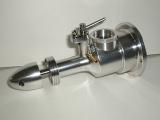 Back to the book. Following a family history, a description of the "shop" shoe-horned into a very modest house, and a Q and A interview with Ira regarding how the engines were made, the book presents 3-view CAD drawing and a one page write-up on every Pep engine the author could identify, even one-off prototypes and an engine that got no further than drawings. While bore and stroke are stated, very little internal details are given, so replica builders will have to use a lot of ingenuity. That's exactly what Les Stone is doing in producing a "hogged from the solid" version of the Pepperell 23 pictured here. The Pepperells did their own die casting for the crankcases using material salvaged from aircraft parts. Les has screwed in the cylinder mount and chosen to make a feature of it, rather than hide the assembly technique. The Pep diesels were rather unique: no needle valve! Instead, a fixed jet gave the owner one less thing to play with and worry about (at least that was the theory).
Back to the book. Following a family history, a description of the "shop" shoe-horned into a very modest house, and a Q and A interview with Ira regarding how the engines were made, the book presents 3-view CAD drawing and a one page write-up on every Pep engine the author could identify, even one-off prototypes and an engine that got no further than drawings. While bore and stroke are stated, very little internal details are given, so replica builders will have to use a lot of ingenuity. That's exactly what Les Stone is doing in producing a "hogged from the solid" version of the Pepperell 23 pictured here. The Pepperells did their own die casting for the crankcases using material salvaged from aircraft parts. Les has screwed in the cylinder mount and chosen to make a feature of it, rather than hide the assembly technique. The Pep diesels were rather unique: no needle valve! Instead, a fixed jet gave the owner one less thing to play with and worry about (at least that was the theory).
The Pepperell book holds nuggets a-plenty, many more than I have the time to relate here. My own peculiar fixation is adequatly catered for by the goodly number of in-line and opposed Pep twins described—although a photo on page 129 is mis-captioned as being a model powered by the 61 twin cylinder glow engine when it's very obviously the '47 twin cylinder 46 diesel. Other chapters detail the tie between the Pepperells and the Dooling brothers, the reasons for the strong family resemblance between the Godwit petrol engines and the M&M, their propeller making machine, and more. The historic perspective suggests that their diesel production preceded the Brits and would have more than held their own against the early EDs and Mills of the same time frame. All in all, a well produced, enjoyable book, at a reasonable price.
The next book is one I'd forgotten about until reminded by a reader of last month's ET Westbury Tribute. Author Nevil Shute's fiction has been given the film treatment at least three times that I can think of: his 1948 book No Highway was filmed in 1951 as No Highway in the Sky. It prophetically dealt with metal fatigue of a modernistic airliner named the "Reindeer". Two years later, the first operational jet airliner, the DH Comet, would fall victum to metal fatigue induced catastrophic in-flight failure. Stranger still (play Twilight Zone theme here) is the fact that Shute was an former de Havilland engineer. Next, we have On the Beach—a grim post nuclear apocalypse story shot here in Australia in 1959. Actress Ava Gardner is alleged to have quipped that if you are making a film about the end of the world, Melbourne is the perfect place to do it! Unsurprisingly, Melbournians were allegedly not amused. And unsurprisingly, the rest of us were. The third is A Town Like Alice, and I'll spare you any trivia about that one.
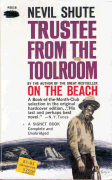 So where is all this going and what does it have to do with model engineering? Well, Shute's last novel, published in 1960, is a delightful little yarn called The Trustee from the Toolroom. In the story, an unassuming, poorly educated, but resourceful model engineer sadly becomes the trustee for his sister's estate. He uses his model-makers' ingenuity to quietly overcomes seemingly insurmountable obstacles and see that his niece receives her inheritance. The fictional character, Keith Stewart, is editor of the Miniature Mechanic, so the connection starts to become clearer (think of Sparey as editor of Model Mechanic, Westbury's regular IC Topics column in the Model Engineer). Shute himself had published in the ME and was building a Westbury Seal Major at the time of his death. Some say it was ETW who was the inspiration for Keith Stewart. Others contend it was L.B.S.C. (aka Lillian "Curly" Lawrence), a most prolific writer in the ME and designer of an astonishing number of scale model live-steam locomotives. I lean towards the ETW connection and you'll have to read the book to find out why. A quick search shows it's not hard to get a second hand copy, and even more astonishing, Amazon lists it as a current reprint title in paperback! Nevil Shute's autobiography, Slide Rule, would probably also be worth reading. Ok, enough fiction already; back to reality...
So where is all this going and what does it have to do with model engineering? Well, Shute's last novel, published in 1960, is a delightful little yarn called The Trustee from the Toolroom. In the story, an unassuming, poorly educated, but resourceful model engineer sadly becomes the trustee for his sister's estate. He uses his model-makers' ingenuity to quietly overcomes seemingly insurmountable obstacles and see that his niece receives her inheritance. The fictional character, Keith Stewart, is editor of the Miniature Mechanic, so the connection starts to become clearer (think of Sparey as editor of Model Mechanic, Westbury's regular IC Topics column in the Model Engineer). Shute himself had published in the ME and was building a Westbury Seal Major at the time of his death. Some say it was ETW who was the inspiration for Keith Stewart. Others contend it was L.B.S.C. (aka Lillian "Curly" Lawrence), a most prolific writer in the ME and designer of an astonishing number of scale model live-steam locomotives. I lean towards the ETW connection and you'll have to read the book to find out why. A quick search shows it's not hard to get a second hand copy, and even more astonishing, Amazon lists it as a current reprint title in paperback! Nevil Shute's autobiography, Slide Rule, would probably also be worth reading. Ok, enough fiction already; back to reality...
Bristol Hydra Progress
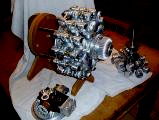
Just before print time last month, I received an email and some photos from Brian Perkins whose magnificent Bristol Hydra is taking shape at last. Brian says:
I thought you might like to have the first look at the engine now that it has got it's cylinders and cam boxes assembled. All I have to do now is get all those valves, cams and gears into the thing. I think the language is going to get quite fruity at times judging by the struggle I had just getting ONE nut onto each of the cylinders. I have said it before but I think assembling the beast is going to be far more difficult than making the bits and pieces.
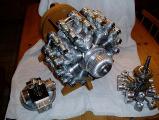 That's going to be a hard assertion to disagree with. Look at all the studs around the cylinder flanges and notice how each cylinder bank will have a pair of camshafts running through the heads that will have to spin freely after all the nuts are tightened. Now apart from the outstanding job Brian has done machining this beast (no castings used), notice the neat rotary stand that will hold the engine during assembly, and all the spark plug leads that will have to eventually snake out of the distributor on the accessory cover assembly. Even if it did not run it would be an outstanding achievement, but I'll bet Brian will persevere until it does.
That's going to be a hard assertion to disagree with. Look at all the studs around the cylinder flanges and notice how each cylinder bank will have a pair of camshafts running through the heads that will have to spin freely after all the nuts are tightened. Now apart from the outstanding job Brian has done machining this beast (no castings used), notice the neat rotary stand that will hold the engine during assembly, and all the spark plug leads that will have to eventually snake out of the distributor on the accessory cover assembly. Even if it did not run it would be an outstanding achievement, but I'll bet Brian will persevere until it does.
So that you can refresh your mind about this project, links to other Hydra photos appear below:
Engine Of The Month: Pepperell Half-Inch
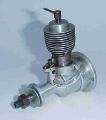
With the Book of the Month giving the VERY complete history of the New Zealand made Pepperell engines, any words that I can add on the topic are probably going to come across as superfluous plagiarism. Never the less, since Dave Owen has one in his collection to provide the photos, click on the pic to read a little bit of history of this unusual 2cc diesel (is not plagiarism, is research!) and perhaps you'll be enticed to buy the book, if you haven't already.
Tech Un-tip of the Month: Making Piston Rings
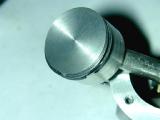
There has been a *lot* of good stuff written about this topic over the years. Today, most will agree that the series of articles on the subject by the late George S Trimble that appeared in Volume 2 of SIC are still the most definitive treatment of the subject. As promised last month, this month's Tech Tip deals with one way of making piston rings for model engines. It's an "Un-tip" because while writing it up, I finally understood that I had completely misunderstood one step of the process. You can read all about in it's gory detail in the Feeney Construction Log, Page 8. Even though I chose the Trimble method, I researched other writings on the subject, including Chaddock, Westbury, and Walshaw (aka Tubal Cain) from the pages of the Model Engineer, as well as a completely different approach taken by fellow ozzie, Paul Chernikeeff (who shares half a surname with me). References appear on the Feeney Log page.
But there is more to piston rings than just making the piston rings themselves. What size should the ring groove be for a given ring? How much cylinder wall clearance should a ringed aluminum piston have? What's the best material for piston rings? The list goes on, and the answers can be found in SIC articles spanning all its years of publication. The part of the Feeney series dealing with piston ring production contains references to the main articles that I found useful. I could paraphrase these, but they really should be read in their entirety. I can only say again that if you are serious about making model engines as a hobby, a full set of SIC is an invaluable resource, and not as expensive as some of the useless tooling I'm sure we've all bought at some stage and no longer want to talk about...
Rotec R2800 Radial
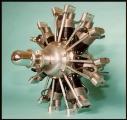
Excuse me if I've written about this in passing before, but having mentioned Paul Chernikeeff, an update on his little radial is probably in order. Back in the last century, Paul had a bit of a fixation over the Gee Bee racer and built a large scale R/C model powered by the ubiquitous chain-saw engine. Disliking the sound, he decided to make his own 350cc, seven cylinder radial to power the model. This was done and was sufficiently successful that reports appeared stating that he planned to make these for sale to other large scale modelers. A short article on the engine appeared in SIC in 2000, condensed from a longer article in the Australian magazine Airborne; the latter including numerous color photos of the engine in various stages of assembly. I have that issue someplace, but have so far totally failed to locate it. Still, I found the SIC issue to get the spelling of his name right when mentioning his unusual method of making piston rings for the Feeney construction page.
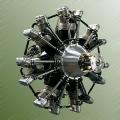 Some time ago, I happened to notice that he had scaled up his model engine to 2800cc and 110 HP for use by homebuild aircraft builders who know that Real Airplanes Have Round Engines. The website I had bookmarked for this enterprise (a scaled-down PT17 homebuilt kit maker) subsequently went silent-key on us, but a quick Guidebeam search for "chernikeeff engine" has found Rotec Radial Engines. I have to take my hat well and truly off to his achievement. The site has lots of pictures of the engine and many links to projects which the engine is being installed in. No mention is made of any commercial production of the original 350cc "model" variant, so I must assume none were ever produced. But I bet he no longer makes piston rings the way he described them being made for the 350cc version, if he makes them at all. Now, hands up those who have noticed the STRONG family resemblance to the Hodgson radial heads hiding under the rocker covers?
Some time ago, I happened to notice that he had scaled up his model engine to 2800cc and 110 HP for use by homebuild aircraft builders who know that Real Airplanes Have Round Engines. The website I had bookmarked for this enterprise (a scaled-down PT17 homebuilt kit maker) subsequently went silent-key on us, but a quick Guidebeam search for "chernikeeff engine" has found Rotec Radial Engines. I have to take my hat well and truly off to his achievement. The site has lots of pictures of the engine and many links to projects which the engine is being installed in. No mention is made of any commercial production of the original 350cc "model" variant, so I must assume none were ever produced. But I bet he no longer makes piston rings the way he described them being made for the 350cc version, if he makes them at all. Now, hands up those who have noticed the STRONG family resemblance to the Hodgson radial heads hiding under the rocker covers?
LME-370 "Pip" Three Cylinder Radial
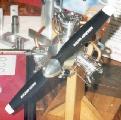
In the April 2003 issue, I mentioned that Todd Snouffer of Little Locos dot com was designing a three cylinder, four-stroke radial, based on the Morton M5 and planned to release drawings for it, when complete. News from Todd this month informs us that development is complete and the plans (28 CAD sheets) and machining instructions (36 pages) are now available. The "Pip" uses a planetary gearing system to drive the (separate) exhaust and inlet cams running at 4:1 reduction, and positions these at the front of the engine. By using glow-plug ignition, the need for a 1/2 speed intermediate take-off for the distributor drive is eliminated, along with a lot of the Morton look. But I think the engine can stand on it's own quite well. Have a look at Little Locos' web site for details and some construction photos. I particularly liked the way Todd made his rockers, cookie-style 
New Engines in the Finder

Here's one to set all collectors' hearts a-flutter: A rare, new-in-box VECO 35C Combat engine—so rare, I'd never heard of it. That may be because, as the lucky new owner relates, the maroon "C" on the side of the bypass was stamped in an ink or paint that washed off as soon as it got a wiff of fuel—probably high nito to boot, given the application—making it look like a much more mundane VECO. As can be seen here, the engine is about as pristine as it's possible to get, considering its age. The fuzz that's grown on the (cad plated?) needle valve adds to the authenticity. Finds like this are rare, but they are out there.
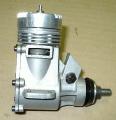 So the VECO 35C is now in the Engine Finder, along with a Fox Mk III Combat Special. This Fox is one of a series known as the "high back door" engines, so called because the backplate came half way up the cylinder liner. This was a neat solution by Duke of how to die cast Schnurle transfer ports. The problem is how to get the casting out of the die. The more common solution (used by Taipan, Bugl, and others) is to cast the section of case containing the transfer passages as a separate band extending from the top of the crankshaft volume, to the top of the exhaust, allowing the intricate transfer passages to be "open" until the halves are bolted together. Another solution is to use an investment casting, but this is rather expensive for high volume production. Duke's solution was a large opening in the rear of the engine that allowed the front passage to be in the die protrusion. The rear passage was cast as part of the large backplate. The series ran well and proved quite crash resistant, despite the delicate look to the giant, 6 screw backplate.
So the VECO 35C is now in the Engine Finder, along with a Fox Mk III Combat Special. This Fox is one of a series known as the "high back door" engines, so called because the backplate came half way up the cylinder liner. This was a neat solution by Duke of how to die cast Schnurle transfer ports. The problem is how to get the casting out of the die. The more common solution (used by Taipan, Bugl, and others) is to cast the section of case containing the transfer passages as a separate band extending from the top of the crankshaft volume, to the top of the exhaust, allowing the intricate transfer passages to be "open" until the halves are bolted together. Another solution is to use an investment casting, but this is rather expensive for high volume production. Duke's solution was a large opening in the rear of the engine that allowed the front passage to be in the die protrusion. The rear passage was cast as part of the large backplate. The series ran well and proved quite crash resistant, despite the delicate look to the giant, 6 screw backplate.
 Seriously Schnuerle
Seriously Schnuerle
 Constant Pressure Engines
Constant Pressure Engines
 The All Crow Diet
The All Crow Diet
 Hydra Progress
Hydra Progress
 Rotec R2800 Radial
Rotec R2800 Radial
 LME370 PIP Three Cylinder Radial
LME370 PIP Three Cylinder Radial
 New Engines in the Finder
New Engines in the Finder
 Editorial
Editorial
 New Books and Magazines This Month
New Books and Magazines This Month
 Engine Of The Month: Pepperell Half-Inch
Engine Of The Month: Pepperell Half-Inch
 Tech Un-tip of the Month: Making Piston Rings
Tech Un-tip of the Month: Making Piston Rings
 Standard Stuff
Standard Stuff



 The neat little radial turns out 65HP at 3000RPM and is intended as a more reliable, quieter, 4-stroke alternative for the 2-strokes powering a lot of ultralights today. It uses VW cylinders, pistons and valves (stainless racing type), but the rest is made by CPI. Unfortunately the site does not give any pictures of the engine with the rocker covers off, but from the text explanation of how the rockers and fore-aft valves are actuated, I think I can almost comprehend it—with stress on the "almost". The site also has some photos of a twin cylinder, horizontally opposed engine that segues neatly into the next item:
The neat little radial turns out 65HP at 3000RPM and is intended as a more reliable, quieter, 4-stroke alternative for the 2-strokes powering a lot of ultralights today. It uses VW cylinders, pistons and valves (stainless racing type), but the rest is made by CPI. Unfortunately the site does not give any pictures of the engine with the rocker covers off, but from the text explanation of how the rockers and fore-aft valves are actuated, I think I can almost comprehend it—with stress on the "almost". The site also has some photos of a twin cylinder, horizontally opposed engine that segues neatly into the next item:




 So where is all this going and what does it have to do with model engineering? Well, Shute's last novel, published in 1960, is a delightful little yarn called The Trustee from the Toolroom. In the story, an unassuming, poorly educated, but resourceful model engineer sadly becomes the trustee for his sister's estate. He uses his model-makers' ingenuity to quietly overcomes seemingly insurmountable obstacles and see that his niece receives her inheritance. The fictional character, Keith Stewart, is editor of the Miniature Mechanic, so the connection starts to become clearer (think of Sparey as editor of Model Mechanic, Westbury's regular IC Topics column in the Model Engineer). Shute himself had published in the ME and was building a Westbury Seal Major at the time of his death. Some say it was ETW who was the inspiration for Keith Stewart. Others contend it was L.B.S.C. (aka Lillian "Curly" Lawrence), a most prolific writer in the ME and designer of an astonishing number of scale model live-steam locomotives. I lean towards the ETW connection and you'll have to read the book to find out why. A quick search shows it's not hard to get a second hand copy, and even more astonishing, Amazon lists it as a current reprint title in paperback! Nevil Shute's autobiography, Slide Rule, would probably also be worth reading. Ok, enough fiction already; back to reality...
So where is all this going and what does it have to do with model engineering? Well, Shute's last novel, published in 1960, is a delightful little yarn called The Trustee from the Toolroom. In the story, an unassuming, poorly educated, but resourceful model engineer sadly becomes the trustee for his sister's estate. He uses his model-makers' ingenuity to quietly overcomes seemingly insurmountable obstacles and see that his niece receives her inheritance. The fictional character, Keith Stewart, is editor of the Miniature Mechanic, so the connection starts to become clearer (think of Sparey as editor of Model Mechanic, Westbury's regular IC Topics column in the Model Engineer). Shute himself had published in the ME and was building a Westbury Seal Major at the time of his death. Some say it was ETW who was the inspiration for Keith Stewart. Others contend it was L.B.S.C. (aka Lillian "Curly" Lawrence), a most prolific writer in the ME and designer of an astonishing number of scale model live-steam locomotives. I lean towards the ETW connection and you'll have to read the book to find out why. A quick search shows it's not hard to get a second hand copy, and even more astonishing, Amazon lists it as a current reprint title in paperback! Nevil Shute's autobiography, Slide Rule, would probably also be worth reading. Ok, enough fiction already; back to reality...








